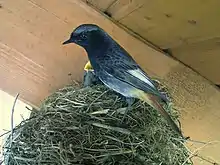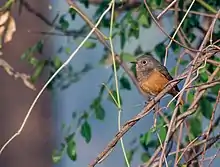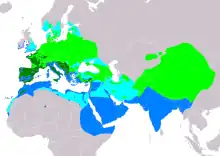| Black redstart | |
|---|---|
 | |
| Male subspecies Phoenicurus ochruros gibraltariensis at nest, Germany | |
 | |
| Female, Vasai, Maharashtra, India
| |
| Scientific classification | |
| Domain: | Eukaryota |
| Kingdom: | Animalia |
| Phylum: | Chordata |
| Class: | Aves |
| Order: | Passeriformes |
| Family: | Muscicapidae |
| Genus: | Phoenicurus |
| Species: | P. ochruros |
| Binomial name | |
| Phoenicurus ochruros (Gmelin, S.G., 1774) | |
| Subspecies | |
|
5–7, see text | |
 | |
Breeding Resident Passage Non-breeding Compiled by: BirdLife International and Handbook of the Birds of the World (2019) 2018. | |
| Synonyms | |
The black redstart (Phoenicurus ochruros) is a small passerine bird in the genus Phoenicurus. Like its relatives, it was formerly classed as a member of the thrush family (Turdidae), but is now known to be an Old World flycatcher (Muscicapidae). Obsolete common names include Tithys redstart, blackstart (not to be confused with the species currently known as blackstart) and black redtail.
Taxonomy and systematics
The first formal description of the black redstart was by the German naturalist Samuel Gottlieb Gmelin in 1774 under the binomial name Mottacilla ochruros.[3][4] The species is now placed in the genus Phoenicurus that was introduced in 1817 by the English naturalist Thomas Forster.[5] Both parts of the scientific name are from Ancient Greek and refer to the colour of the tail. The genus name Phoenicurus is from phoinix, "red", and -ouros -"tailed", and the specific ochruros is from okhros, "pale yellow" and -ouros.[6]
The black redstart is a member of a temperate Eurasian clade, which also includes the Daurian redstart, Hodgson's redstart, the white-winged redstart and perhaps Przevalski's redstart. The ancestors of the present species diverged from about 3 million years ago (mya) (Late Pliocene) onwards and spread throughout much of Palearctic from 1.5 mya onward.[7] It is not very closely related to the common redstart. As these are separated by different behaviour and ecological requirements and have not evolved fertilisation barriers, the two European species can produce apparently fertile and viable hybrids.[8][9][10]
There are a number of subspecies, which differ mainly in the underpart colours of the adult males and, for some forms, calls;[11] different authorities accept between five and seven subspecies. They can be separated into three major groups, according to morphology, biogeography and mtDNA cytochrome b sequence data.[7][9][12][13]
P. o. phoenicuroides group. Basal central and eastern Asian forms which diverged from the ancestral stock as the species slowly spread west (c. 3–1.5 mya). Females and juveniles light grey brown.
- Phoenicurus ochruros phoenicuroides (Moore, F, 1854) – Tian Shan eastwards to Mongolia. Small; adult males have lower breast, belly and flanks deep rufous, pale wing-patch absent, sometimes white forehead. Overall quite similar to a much darker common redstart with black chest. Females and juveniles are similar to common redstart but have an overall sandier, paler colour and often a distinct buff eye-ring.
- Phoenicurus ochruros murinus Fedorenko, 2018 – Altai, Tuva, northern China and western Mongolia. Distinguished from the previous Turkestan subspecies by the absence of any contrast in the colour of the head, nape and back, all of which are concolorous dark grey.[14]
- Phoenicurus ochruros rufiventris (Vieillot, 1818) – Turkmenistan eastwards through Pamir and Alay Mountains to Himalaya. Usually large; adult males like P. o. phoenicuroides, but darker overall, with black back and rufous-chestnut underside. Females with rufous tinge to underside. Exact limits with P. o. phoenicuroides unresolved.
P. o. ochruros group. Western Asian forms, whose lineage separated from the gibraltariensis group c. 1.5–0.5 mya. Females and juveniles intermediate.
- Phoenicurus ochruros ochruros (Gmelin, SG, 1774) – Eastern Turkey, Alborz, and Caucasus. Small, somewhat intermediate between P. o. phoenicuroides and P. o. gibraltariensis. Generally like latter, but rufous underside, pale wing patch weakly developed.
- Phoenicurus ochruros semirufus (Hemprich & Ehrenberg, 1833) – Levant. Small; adult males somewhat similar to rufiventris except in size. Black areas extensive.
P. o. gibraltariensis group. European population, which formed as a distinct subspecies probably during the last ice age. Females and juveniles dark grey.
- Phoenicurus ochruros gibraltariensis (Gmelin, JF, 1789) – Western Europe east to the Crimea and western Turkey. Neck, upper back and shoulders dark slate grey to black in adult males, lighter than face and neck, pale wing patch strongly developed.
Description
The black redstart is 13–14.5 cm (5.1–5.7 in) in length and 12–20 g (0.42–0.71 oz) in weight, similar to the common redstart. The adult male is overall dark grey to black on the upperparts and with a black breast; the lower rump and tail are orange-red, with the two central tail feathers dark red-brown. The belly and undertail are either blackish-grey (western subspecies; see Taxonomy and systematics, above) or orange-red (eastern subspecies); the wings are blackish-grey with pale fringes on the secondaries forming a whitish panel (western subspecies) or all blackish (eastern subspecies). The female is grey (western subspecies) to grey-brown (eastern subspecies) overall except for the orange-red lower rump and tail, greyer than the common redstart; at any age the grey axillaries and underwing coverts are also distinctive (in the Common Redstart these are buff to orange-red). There are two distinct forms in first calendar year males at least in western subspecies, with the first ('carei') being similar to females and the second ('paradoxus') approaching adult males but lacking the whitish wing panel that does only develop during post-breeding moult of wing feathers in the second calendar year. This second form is much rarer than the first. [12][13] [15]


Distribution and habitat
It is a widespread breeder in south and central Europe and Asia and north-west Africa, from Great Britain and Ireland (where local) south to Morocco, east to central China. It is resident in the milder parts of its range, but north-eastern birds migrate to winter in southern and western Europe and Asia, and north Africa. It nests in crevices or holes in buildings.[12][13]
In Britain, it is most common as a passage and winter visitor, with only 20–50 pairs breeding.[16] On passage it is fairly common on the east and south coasts, and in winter on the coasts of Wales and western and southern England, with a few also at inland sites. Migrant black redstarts arrive in Britain in October or November and either move on or remain to winter, returning eastward in March or April. They also winter on the south and east coasts of Ireland.[13]
The species originally inhabited stony ground in mountains, particularly cliffs, but since about 1900 has expanded to include similar urban habitats including bombed areas during and after World War II, and large industrial complexes that have the bare areas and cliff-like buildings it favours; in Great Britain, most of the small breeding population nests in such industrial areas. It will catch passing insects in flight, and migrants often hunt in coastal tide-wrack for flies or tiny crustaceans. Its quick ducks of head and body are robin-like, and its tail is often flicked. The male has a rattling song and a tick call.
Eastern race birds are very rare vagrants in western Europe.[8]
Behaviour and ecology
Breeding
Black redstarts are usually monogamous.[17] They start breeding in mid-April. The nest is built by the female and is typically placed in a crevice or hole in rock or a wall or on a ledge of a building. The nest consists of a loose cup of grass and stems and is lined with hair, wool and feathers. The eggs are laid daily. The clutch consists of 4 to 6 eggs that are usually white but can also be pale blue. On average they measure 19.4 mm × 14.4 mm (0.76 in × 0.57 in) and weigh 2.16 g (0.076 oz). Beginning after the final egg is laid, the eggs are incubated by the female for 13–17 days. The young are cared for and fed by both parents and fledge after 12–19 days.[18]
Gallery
-_Male_at_Sultanpur_I_Picture1042.jpg.webp) Male Phoenicurus ochruros rufiventris at Sultanpur National Park in Gurgaon district of Haryana, India
Male Phoenicurus ochruros rufiventris at Sultanpur National Park in Gurgaon district of Haryana, India Levantine black redstart (Phoenicurus ochruros semirufus)
Levantine black redstart (Phoenicurus ochruros semirufus) Black redstart, Phase 7, Mohali, Punjab, India
Black redstart, Phase 7, Mohali, Punjab, India.jpg.webp) Immature European black redstart
Immature European black redstart
References
- ↑ BirdLife International (2019). "Phoenicurus ochruros". IUCN Red List of Threatened Species. 2019: e.T22710051A155610899. doi:10.2305/IUCN.UK.2019-3.RLTS.T22710051A155610899.en. Retrieved 19 November 2021.
- ↑ Bonhote, J. Lewis (1907). Birds of Britain. illustrated by H.E. Dresser. London: Adam and Charles Black. p. 33. OCLC 1451688. See also The Birds of Devon (1892), this image by John Gerrard Keulemans.
- ↑ Gmelin, Samuel Gottlieb (1774). Reise durch Russland zur Untersuchung der drey Natur-Reiche (in German). Vol. 3. Saint Petersburg: Gedruckt bey der Kayserl. Academie der Wissenschaften. p. 101.
- ↑ Mayr, Ernst; Paynter, Raymond A. Jr, eds. (1960). Check-list of Birds of the World. Vol. 10. Cambridge, Massachusetts: Museum of Comparative Zoology. p. 75.
- ↑ Forster, Thomas (1817). A Synoptical Catalogue of British Birds. London: Nichols, Son, and Bentley. p. 53.
- ↑ Jobling, James A. (2010). The Helm Dictionary of Scientific Bird Names. London, United Kingdom: Christopher Helm. pp. 279, 304. ISBN 978-1-4081-2501-4.
- 1 2 Ertan, K.T. (2006). "The evolutionary history of Eurasian Redstarts, Phoenicurus" (PDF). Acta Zoologica Sinica. 52 (Supplement): 310–313.
- 1 2 Steijn, Laurens B. (2005). "Eastern Black Redstarts at IJmuiden, the Netherlands, and on Guernsey, Channel Islands, in October 2003, and their identification, distribution and taxonomy". Dutch Birding. 27 (3): 171–194.
- 1 2 Grosch, K. (2004). "Hybridization between Redstart Phoenicurus phoenicurus and Black Redstart P. ochruros, and the effect on habitat exploitation". Journal of Avian Biology. 35 (3): 217–223. doi:10.1111/j.0908-8857.2004.03128.x.
- ↑ Martinez N., Nicolai B., van der Spek V. (2019) Redstart hybrids in Europe and North Africa. British Birds112:190-210. https://www.researchgate.net/publication/332211724_Redstart_hybrids_in_Europe_and_North_Africa/link/5feaf35645851553a001e6ba/download
- ↑ Martinez N., van der Spek V. (2022) Geographical variation in Black Redstart Phoenicurus ochruros (S. G. Gmelin, 1774) calls. Bulletin of the British Ornithologists' Club 142: 466-477. https://bioone.org/journals/bulletin-of-the-british-ornithologists-club/volume-142/issue-4/bboc.v142i4.2022.a5/Geographical-variation-in-Black-Redstart-Phoenicurus-ochruros-S-G-Gmelin/10.25226/bboc.v142i4.2022.a5.full.
- 1 2 3 4 5 Collar, N.J. (2005). "Black redstart". In del Hoyo, J.; Elliott, A.; Christie, D.A. (eds.). Handbook of the Birds of the World. Vol. 10: Cuckoo-shrikes to Thrushes. Barcelona, Spain: Lynx Edicions. pp. 770–771. ISBN 978-84-87334-72-6.
- 1 2 3 4 Snow, D.W.; Perrins, C.M. (1998). The Birds of the Western Palearctic (Concise ed.). Oxford: Oxford University Press. hdl:11245/1.132115. ISBN 0-19-854099-X.
- ↑ Fedorenko, V.A. (2018). "A new subspecies of the black redstart – Phoenicurus ochruros murinus subsp. nov. from the Altai-Sayan Mountainous Country and the current breeding range of the black redstart". Proceedings of the Zoological Institute RAS. 322 (2): 108–128. doi:10.31610/trudyzin/2018.322.2.108.
- ↑ Gefiedermerkmale, Maße und Alterskennzeichen des Hausrotschwanzes Phoenicurus ochruros limicola.de (in German) Retrieved 10 May 2023
- ↑ Holling, M.; Rare Breeding Birds Panel (2010). "Rare breeding birds in the United Kingdom in 2008" (PDF). British Birds. 103: 482–538. Archived from the original (PDF) on 2012-02-19. Retrieved 2016-11-20.
- ↑ Villavicencio, C.P.; Apfelbeck, B.; Goymann, W. (2014). "Parental care, loss of paternity and circulating levels of testosterone and corticosterone in a socially monogamous song bird". Frontiers in Zoology. 11 (11): 11. doi:10.1186/1742-9994-11-11. PMC 3932846. PMID 24517241.
- ↑ Cramp 1988, pp. 691–692.
Sources
- Cramp, Stanley, ed. (1988). "Phoenicurus ochruros Black Redstart". Handbook of the Birds of Europe the Middle East and North Africa. The Birds of the Western Palearctic. Vol. V: Tyrant Flycatchers to Thrushes. Oxford: Oxford University Press. pp. 683–695. ISBN 978-0-19-857508-5.
External links
- BirdLife species factsheet for Phoenicurus ochruros
- "Black redstart media". Internet Bird Collection.
- Black redstart photo gallery at VIREO (Drexel University)
- Interactive range map of Phoenicurus ochruros at IUCN Red List maps
- Phoenicurus ochruros in Field Guide: Birds of the World on Flickr
- Black redstart media from ARKive
